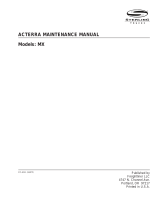
3
Type NR oil switch installation and operation instructions
INSTALLATION AND OPERATION INSTRUCTIONS MN230008EN November 2016
Installation procedure
WARNING
Do not operate this equipment if energized parts are not
immersed in dielectric fluid. Operation when parts are
not properly immersed in dielectric fluid may result in
internal flashovers that will damage the equipment and
can cause death or severe personal injury. G104.4
CAUTION
This equipment relies on dielectric fluid to provide
electrical insulation between components. The dielectric
strength of the fluid must be checked on a regular basis,
as part of the routine maintenance inspection, to ensure
that it is at or above minimum dielectric requirements.
Use of this equipment with dielectric fluid that does not
meet minimum requirements can result in internal
flashovers that will damage the equipment and can
cause personal injury. G107.3
Check-out procedure
1. Untank the switch. When untanking the switch for
inspection, remove the four bolts that secure the tank
and head casting. Trip the switch and carefully lift the
mechanism.
2. Check oil level. Before installing the switch, check for
proper oil level. With the mechanism removed from the
tank, the oil level should be even with the top of the
tank liner.
3. Test oil dielectric strength. If the switch has been
stored for some time or is being relocated, perform a
dielectric test on the oil. Refer to Reference Data
TD280022EN, Oil Specifications and Tests for test
procedures and test values. Oil that does not meet
specifications should be replaced. Approximately
1-1/2 gallons are required.
4. Replace head casting and mechanism in tank.
A. Wipe clean the O-ring type gasket and the tank
gasket seat.
B. Place head and mechanism assembly into the tank.
The head can be rotated to any position except
where the actuator housing or manual operating
handle interfere with the tank mounting bracket.
C. Position the four head bolts, with fasteners under
the tank lip, and tighten alternately (torque to
10 - 14 ft lbs).
5. Test mechanical operation. CLOSE and OPEN the
switch contacts manually using the yellow operating
handle. Confirm that the contacts have closed and
opened by listening for the sound of operation or by a
continuity check between the switch bushings. Leave
the contacts in the open position.
6. Check data plate. Make sure that ratings on the data
plate are correct for the planned installation.
WARNING
This equipment is not intended to protect human
life. Follow all locally approved procedures and safety
practices when installing or operating this equipment.
Failure to comply can result in death, severe personal
injury, and equipment damage. G102.1
7. Mount the switch. The switch can be direct pole
mounted with a through-bolt. Mounting hardware
is also available for substation and cross-arm pole
mounting. Dimensions to determine mounting position
and clearances are shown in Figures 5, 6 and 7.
Main wiring
WARNING
Hazardous voltage. Solidly ground all equipment. Failure
to comply can result in death, severe personal injury,
and equipment damage. T223.2
1. Ground the switch. Make the ground connection to
the ground connector (located 3” from the bottom of
the tank).
2. Make line connections. Connect the primary leads to
the switch bushing terminals. The universal clamp type
terminals accommodate No. 8 solid through
2/0 stranded conductor.
Control wiring
Connections
Connections to the actuating mechanism are made at a
terminal strip located in the actuator housing. Wiring access
is through a 1-1/16” diameter opening in the bottom of the
housing. Receptacles are supplied with 5-pin, 3-conductor
or 6-pin, 6-conductor configurations as standard from
thefactory.
The terminal strip is factory wired to an accessory
receptacle mounted in the bottom of the housing. Wiring
and receptacle combinations are available to accommodate
various combinations of accessories. Mating plugs for
the accessory receptacles must be ordered separately.
Maximum cable and wire sizes accommodated by the plugs
are tabulated in Table 3.
Pin orientation diagrams for the accessory receptacles are
shown in Figure 1.
Table 3. Control wiring specifications
Accessory plug catalog
number
Number
of pins
Cable range
O.D. (in.)
Maximum
wire size
AWG
CCR010P1 5 0.437-0.562 12
CCR009P1 6 0.500-0.625 16













